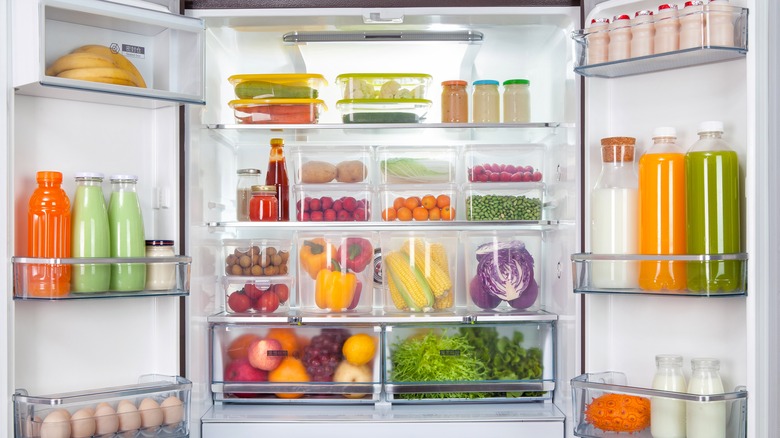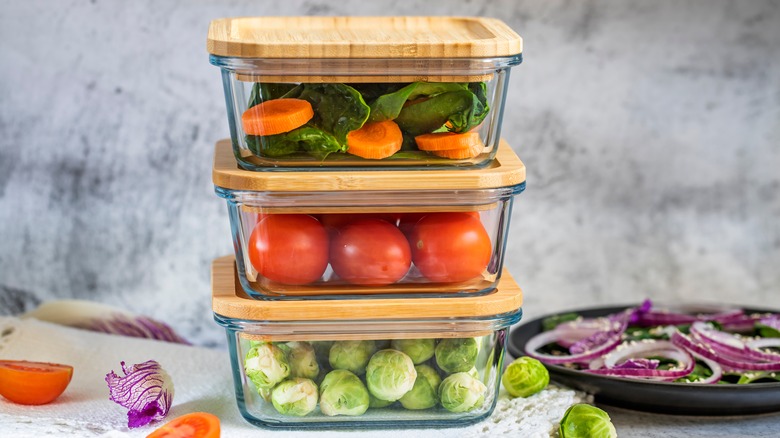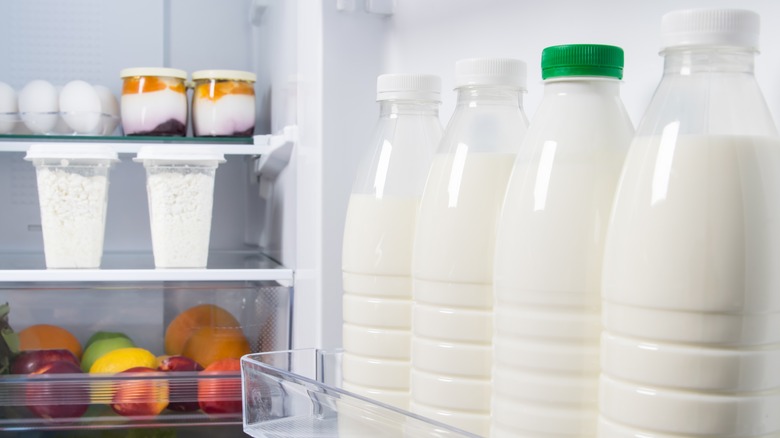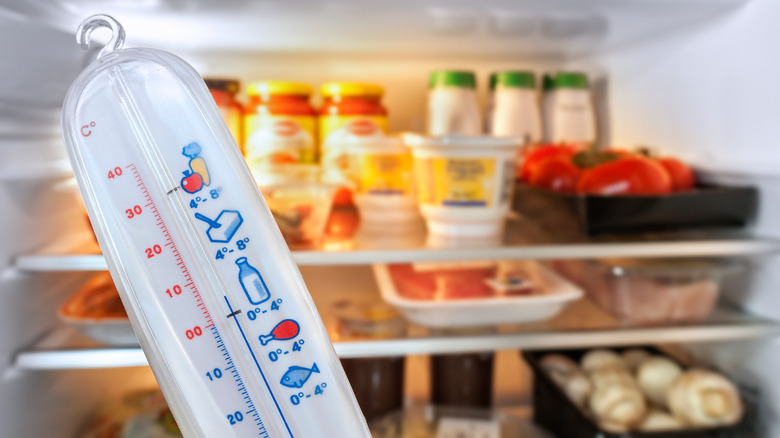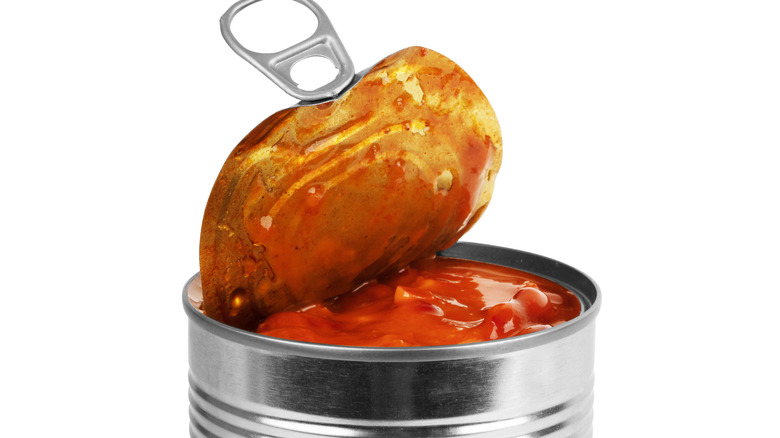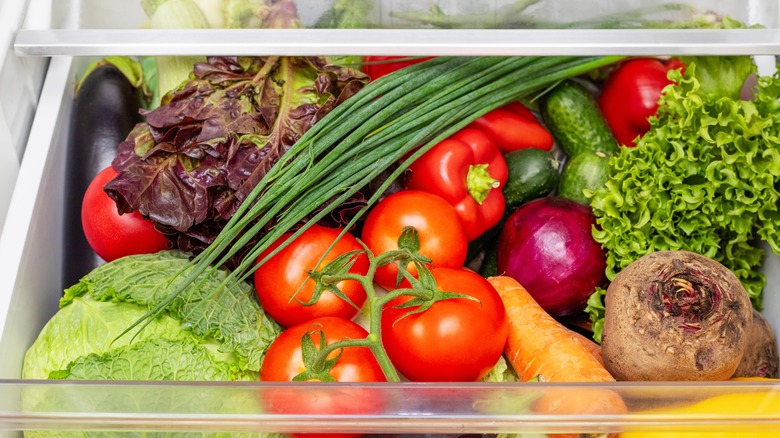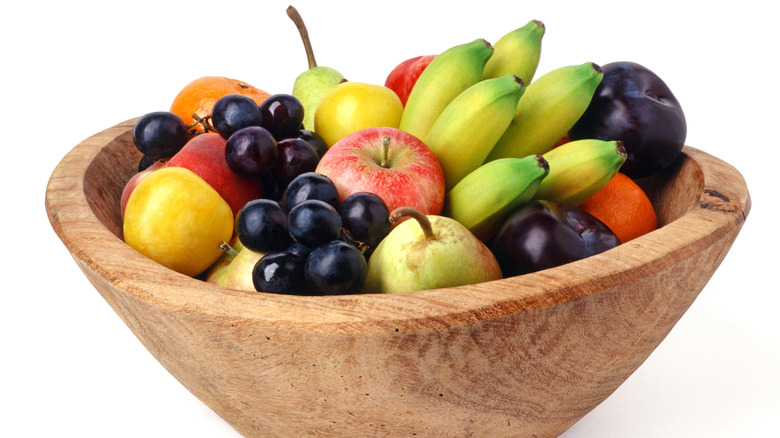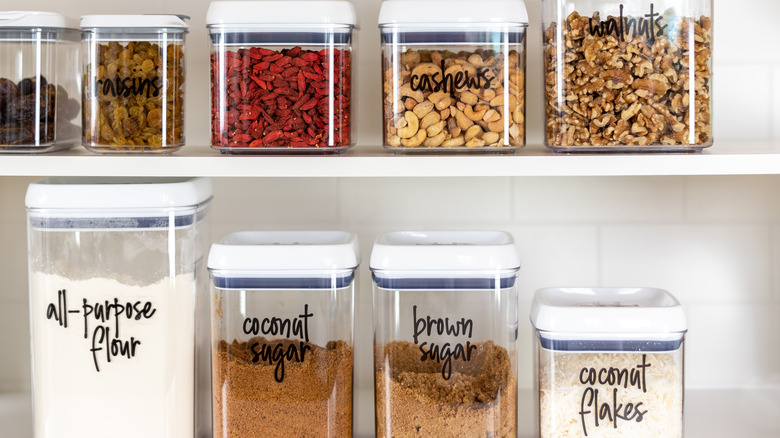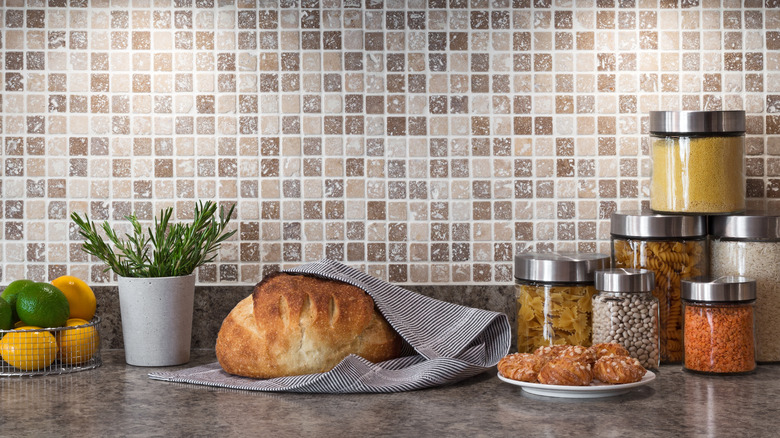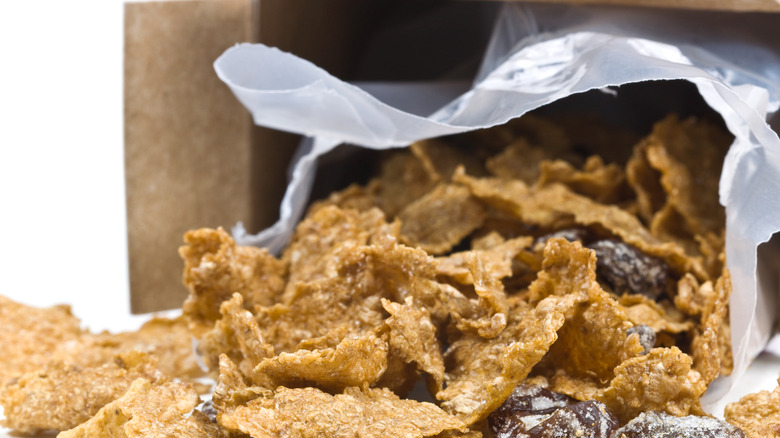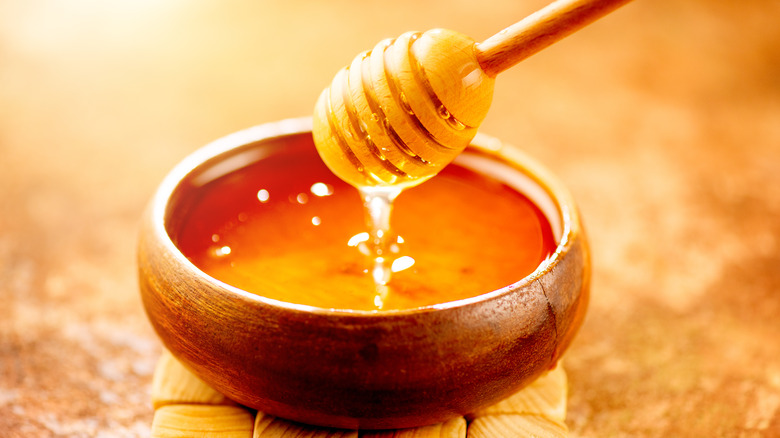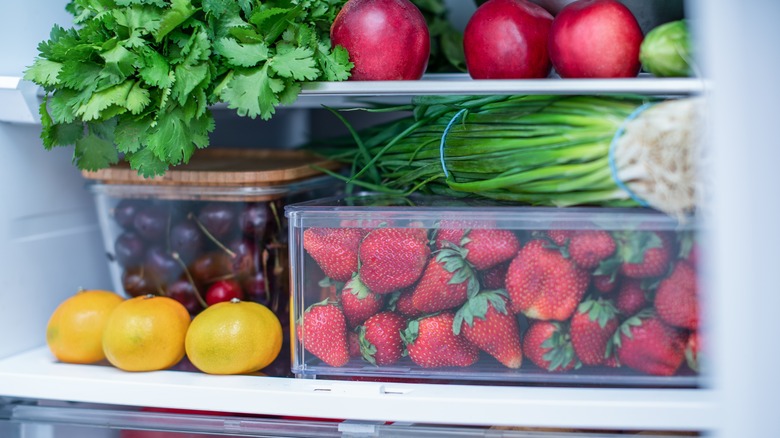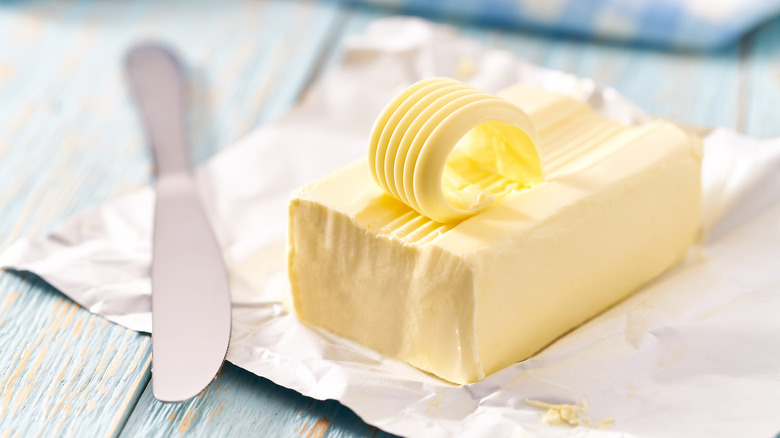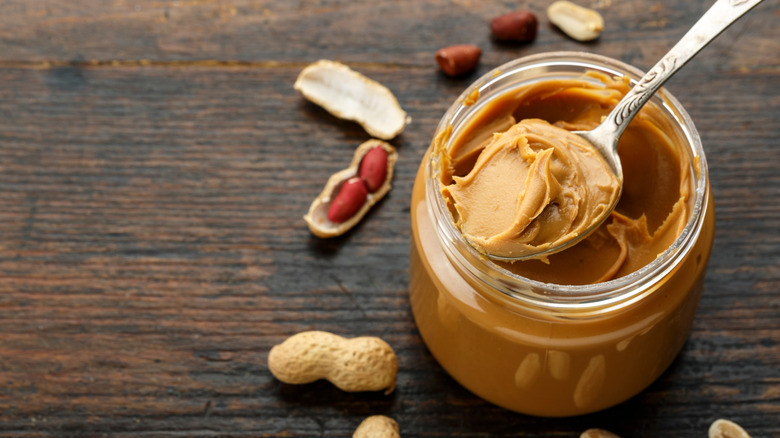Food Storage Mistakes You Need To Stop Making
With so many of people trying to cut down on food waste for both ecological and financial reasons, preventing the food you buy from going bad is more crucial than ever. While the first step is to make sure you don't buy more food than you need in the first place, properly storing food is key in preventing spoilage. Sorting out your kitchen storage may seem like a mundane task, but just a few simple tweaks can make a big difference to the quality and longevity of food and save you a lot of money in the long run.
Organizing your kitchen is about so much more than just keeping things tidy; it means understanding the needs of certain foods and creating an environment for each one to stay fresh as long as possible. Let's embrace the challenge of sustainable eating by exploring the storage mistakes often made and how to remedy them. By giving every ingredient the best chance of thriving, you can enjoy cooking and eating your food to the maximum.
Storing food uncovered
We've all been there, heading into the kitchen before bed and seeing the leftover portions of dinner sitting on the worktop, needing to be put away in the fridge. In a perfect world, of course, we would find a clean tub fitting lid, label it, and stack it neatly on top of all other leftover food in the fridge, keeping it all fresh for as long as possible. Many of us, however, might not think about how to create the best environment for this task — but it's crucial to understand the difference it can make in keeping food fresh.
The most noticeable problem with uncovered food is the taste and texture. Uncovered food will dry out quickly, meaning the texture will not be what you want the following day. Strong flavors can also affect food — for example, your delicious pumpkin pie will absorb the flavors of your garlic bread if you're not careful — and that's not really a flavor combination we want to try. Another important reason to cover your food is to prevent cross-contamination and potential food poisoning. Raw meat and fish contain harmful bacteria that could be passed on to cooked food, increasing the chances of you getting sick.
The best way to protect your food and keep it as fresh as possible is to store it in an airtight container, creating a physical barrier between your leftovers and potential contaminants. If you are running short of time or containers, covering the plate with plastic wrap or aluminum foil will still provide some protection.
Placing highly perishable items in the fridge door
When it comes to storing food in the refrigerator, sometimes the easiest thing is to chuck it in the fridge door and forget about it. It's where most of us keep our milk, eggs, and random jars that we likely forget about for months. But the fridge door is not a great place to store any food items that can spoil quickly. Every time you open the door, the items in the fridge are exposed to the warm air, meaning the temperature is much less consistent than the main section of the fridge.
Milk, eggs, cheese, and meat should all be kept out of the door shelves and placed near the back of the fridge. These foods are highly perishable and can cause food poisoning if not chilled correctly, so keeping them cool is crucial. It may be convenient to grab the milk bottle from the fridge door whenever you make a cup of coffee, but it is not worth the risk of getting sick. Instead, keep items in the door that are more robust and only need to be refrigerated once opened. Think pickles, ketchup, pesto, and salad dressings. Other drinks, such as water and soda, will also be perfectly safe in the warmer section of the fridge. So keep that milk carton or bottle on one of the main fridge shelves.
Waiting for food to cool down before refrigerating
How often have you thought, "I can't put that food in the fridge just now, I'll wait until it cools down?" It seems logical that warm food and a cold fridge shouldn't mix, but in terms of food hygiene, it's actually not best practice. The longer your food sits on the countertop, the more it becomes a breeding ground for bacteria, so cooling it quickly is the best option. According to the USDA, the "danger zone" for food lies between 40 and 140 degrees F. Within this temperature range, the bacteria can double in as little as 20 minutes, meaning as soon as the food falls into this range, you should refrigerate it to cool it down as quickly as possible rather than letting it cool to room temperature first.
Of course, you need to think of practicality, too, as putting a whole chicken into the fridge straight from the oven is probably not the best idea either. Think of long-term storage, and prepare the food before refrigerating by separating it into smaller portions and storing it in airtight containers. Splitting the hot food up will also put less pressure on the fridge, which will have to work hard to cool the temperature down. Modern refrigerators can handle warm food in small batches, so let your food cool slightly, but be sure not to leave it sitting for more than two hours to keep your leftovers safe and delicious for the next day.
Storing food in an open can
After opening a can of beans and having half of them for your lunch, popping the open can back into the fridge to keep for later seems like the logical thing to do. After all, they already come in their own handy container, so it makes sense, right? Well, no, storing open cans in the fridge is not a good idea for a few reasons. Firstly, there is a small chance of metal or plastic leaching in to the food, which can cause health problems in the long term. The cans contain both tin and BPA, neither of which you want to be ingesting. While the chances of this may be small, consistently allowing your food to be exposed to these toxins isn't ideal.
The main reason you don't want to store your food in an open tin is flavor. Once a can is open, the foods become exposed to the air, meaning they begin to degrade. An open can is equivalent to leaving food uncovered in the fridge, and the quality and flavor will begin to decrease. Instead, take a few seconds to transfer food to an airtight container, allowing it to stay fresh for a few days. Glass and BPA-free plastic are both good choices that mean you don't need to worry about the food reacting with the container. This way, you can avoid any potential health risks and keep your food tasting better for longer.
Keeping your tomatoes in the fridge
Tomatoes are a staple in most kitchens — full of bright, juicy flavor and packed with vitamin C. They are technically a fruit — though we don't recommend them in a fruit salad — and are such versatile ingredients that the majority of home cooks will always have some on hand. But where should we store these culinary beauties? Most people choose the fridge, but surprisingly, this is not the best choice. Unless you need your toms to last a very long time, you are doing them a disservice by keeping them cool. Storing tomatoes below a temperature of around 54 degrees F puts the brakes on the chemical reaction that creates the flavor molecules, meaning refrigerated tomatoes will be bland and lacking that signature punchy taste.
The ripening process also slows in the fridge, meaning the texture of the tomatoes will be compromised, especially if they are under-ripe when you buy them. Just bear in mind that ripening is essentially the same as rotting, so you need to get the balance between perfectly ripe and starting to decay. If you absolutely need to chill your tomatoes to keep them fresh — for example, in summer when the room is particularly hot — make sure you take them out of the fridge as far in advance as possible, giving them the chance to come up to temperature before adding to your dish.
Storing delicate fruit and vegetables near bananas
When arranging your fruit bowl on the countertop, your first thought is likely to make it look pleasing. Managing to arrange your awkwardly shaped bananas with the rest of the more uniform fruit is an achievement in itself. And while you might feel a sense of accomplishment as you admire your display, your pride won't last long — because within a few days, your fruit will start to look a bit less appetizing.
The culprit behind this deterioration is the ethylene gas produced by bananas as they ripen. On the plus side, it transforms your bananas from overly firm green fruits into sweet, yellow treats — but the problem is it also causes many fruits in the vicinity to ripen too quickly. Some fruits are more sensitive to ethylene than others — apples, peaches, and kiwis are all likely to start going bad near bananas — whereas oranges, tomatoes, and pineapples are unlikely to be affected.
The solution is to store them separately to avoid exposing fruits to the ethylene. Using a banana hanger is a great idea, keeping the bananas looking neat and tidy but away from sensitive foods. If you must store your bananas in the fruit bowl, separate them from the bunch and tie plastic wrap or aluminum foil around the stem of each one to prevent the release of ethylene and prevent other fruits from being affected by it. It will also slow down the ripening of the bananas themselves, though, so if you are planning to make banana bread, this tactic may not work for you.
Not sealing dried foods
Dried foods are such an important feature of our kitchens, their long sell-by dates and lack of refrigeration means they are low-maintenance ingredients that we can have at hand throughout the year. However, sometimes we're guilty of becoming complacent about our dried pantry staples, and storing them incorrectly can lead to a degradation in quality and them needing to be replaced prematurely.
The key to their longevity is in the name — dried foods are ones that have had the water removed and contain less than 25% moisture. This reduces the chances of bacteria building up, so the food can last much longer without going bad. If it is exposed to moisture from the air, this can cause the food to become stale or moldy, meaning it will cost you money in the long run.
To avoid this issue, transfer your pasta, rice, and other dried food to an airtight container as soon as you have opened them. Glass jars and BPA-free plastic tubs are the best options, protecting the food from moisture in the air and pests that could infest your pantry. By purchasing see-through jars and boxes, you can organize your pantry in a way that makes it easy to see at a glance what supplies you have and when they are running low. Following this simple step, your dried goods will maintain their quality of flavor and texture, ensuring they are available for your next culinary adventure.
Leaving your bread on the counter
In your quest for an Insta-ready kitchen, you may have started presenting your bread on the countertop, perhaps with a cloth artistically draped over it. While this may be an aesthetically pleasing setup, it is not the best environment for the bread's longevity and freshness, so you may want to consider a few other options.
One of the best places to keep your bread, whether home-baked or store-bought, is in a bread box. Moisture and light are the enemies of freshness when it comes to bread, and a bread box will protect your loaf from both. There are many modern options for bread boxes, including wood, stainless steel, and ceramic — all of which will equally protect your bread.
If you don't have room on the counter for a bread bin, you will need to find another cool, dry place to store your bread. Do not place on top of the fridge or in a cupboard near the oven, as the heat generated from appliances will cause it to go bad faster. Avoid refrigerating it too — although the low temperature will slow down the production of mold, the bread will go stale quickly, ruining the taste and texture.
You can freeze your bread to increase its longevity. Unless you are planning to eat the whole loaf in one go in the future, however, be sure to slice it before you freeze it — this will help you avoid the dangerous prospect of attempting to saw through a frozen loaf whenever you fancy a slice of toast.
Leaving your cereal in open boxes
Cereal is a breakfast stalwart and staple ingredient in most homes. But with each member of the family potentially eating it throughout the day, from early morning breakfast to late night snacks, storage protocols tend to be forgotten, and cereal boxes lie open for days or even weeks at a time.
To avoid the tragedy of Rice Not-so-Krispies, it's important to find a way to store your cereal that is both effective and easily used by the whole family. Like other dried foods, the culprit is moisture in the air. As the cereal absorbs water, it loses its satisfying crunch and will eventually become chewy — let's be honest, nobody wants to start their morning with chewy cereal!
Transferring your cereals to airtight containers as soon as you open them is the most foolproof way to extend their freshness. With a barrier to keep out the moisture, they should last up to their best before date without losing flavor or texture. If you still want to keep your cereal in its box, here's a life-changing — or at least breakfast-changing — way to fold your cereal box lid properly. It may not keep out moisture as effectively as a plastic storage tub, but it will make your cereal boxes look neater and reduce the chance of spillage!
Storing honey in the fridge
If you are a fan of honey, you will be delighted to know that — when stored properly — this luxurious amber nectar will never spoil. In 1922, edible honey was found in Tutankhamun's tomb, which was thought to be more than 3,000 years old. So it's a relief to know that you don't need to worry about your honey passing its best before date, but it's still important to know how to keep the texture and flavor at its best.
Most of us keep honey in the cupboard until we open it, then into the fridge afterward, but that is far from the best place for it. At low temperatures, the honey begins to crystallize faster than it would at room temperature, causing the texture to change dramatically. Instead of smooth, flowing syrup, you will end up with chunks of solid honey that will not look so great drizzled over your fruit salad. Although the honey will still be perfectly edible, you likely want to keep its smooth texture for as long as possible. The best way to achieve this is to store it in a cool, dark cupboard to keep it away from moisture, light, and extremes of temperature.
If your honey does crystallize, you can return it to its former glory by gently warming the jar in a bowl of hot water and stirring to dissolve the crystals. Don't ever heat honey above 120 degrees F, as this will destroy the bacteria and enzymes that create its powerful health benefits.
Storing food on the wrong shelves in the fridge
Keeping your fridge neat and organized is not just about making it easier to find things, it serves an important purpose in terms of food hygiene, too. Storing items on the wrong shelves can lead to cross-contamination and food going bad more quickly, neither of which is good for your wallet or your health.
The fridge is not uniformly cold, and some foods need to be stored at a lower temperature than others. The bottom shelf will likely be the coldest and should be used to store raw meat, poultry, and fish since these are the foods that spoil easily. Using the bottom shelf also prevents raw meat juices from dripping from higher shelves onto cooked food and transferring dangerous microorganisms that can cause food poisoning.
Dairy products should be stored on the middle shelves, with cooked and ready-to-eat food on the top shelf, which is the warmest. The salad drawer is ideal for storing fruits, vegetables, and salad leaves to keep them fresh and crisp.
The fridge door is the least consistent temperature and should only be used to store foods that don't spoil easily, such as mayonnaise and chutney. Organizing food according to the temperature of the fridge will ensure safety, preserve quality, and reduce food waste.
Using a clear butter dish
Butter is a wonderful staple in the kitchen, used to sauté, in baking, and often spread on a thick slice of crusty bread. But a common quandary in households is how to store the butter to get the most from it. While some insist on using the fridge, is there any more frustrating task than trying to spread refrigerated butter on a piece of soft bread? Something's gotta give, and that something is likely to be your beautiful fluffy bread, left with a gaping hole in the middle and a big chunk of cold butter hanging off the end.
So, assuming you want to spread your butter easily, it's best to store it at room temperature, in a butter dish to reduce mess. The mistake many people make is thinking that a glass or clear plastic butter dish is the way to go. While these look attractive and allow you to see how much butter is left, they speed up the rate at which your butter will spoil. The high fat content of butter means it can become rancid if exposed to heat and light, so keeping it in a dark place is crucial. Generally speaking, it can be left at room temperature for about two weeks when dark, so opt for a ceramic or solid plastic butter dish to keep it fresh for longer.
Storing peanut butter in the pantry
Peanut butter has a famously long shelf life, and most of us are happy to store it in the pantry, even after it has been opened. But, depending on what type of peanut butter you buy, this may not be a good option and could lead to it spoiling far earlier than it should.
Commercial, brand-name peanut butter usually contains stabilizers such as palm oil, which makes it shelf-stable and helps to keep its creamy consistency. However, many people are now looking to natural peanut butter over health concerns regarding palm oil and hydrogenated fats. These peanut butters are made with only peanuts and salt, meaning they don't have the protection of the stabilizers to prevent spoiling. The solution, in this case, is to store your peanut butter in the fridge.
Refrigerating any type of peanut butter will prevent oil separation. Though this process is natural and does not affect the safety or quality of the product, some people are put off by the impact it has on the texture. However, with natural peanut butter, the lower temperature of the fridge will also keep it fresher for much longer, which is especially important if you tend to keep an open jar for many months.
The downside to refrigerating your peanut butter is that it makes it difficult to spread on your toast or bagels. It is worthwhile removing the jar from the fridge in advance if you want to have the perfect spreadable consistency for your snack.

